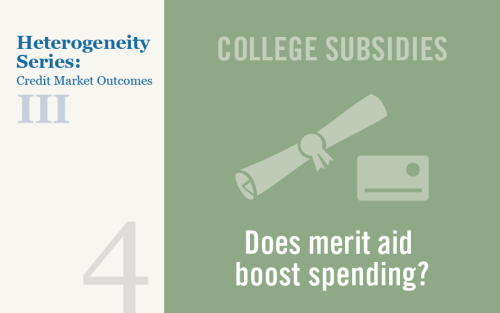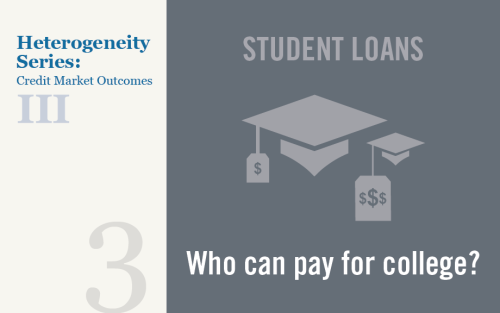Do College Tuition Subsidies Boost Spending and Reduce Debt? Impacts by Income and Race
Rajashri Chakrabarti, William Nober, and Wilbert van der Klaauw

In an October post, we showed the effect of college tuition subsidies in the form of merit-based financial aid on educational and student debt outcomes, documenting a large decline in student debt for those eligible for merit aid. Additionally, we reported striking differences in these outcomes by demographics, as proxied by neighborhood race and income. In this follow-up post, we examine whether and how this effect passes through to other debt and consumption outcomes, namely those related to autos, homes, and credit cards. We find that access to merit aid leads to an immediate but temporary increase in eligible individuals’ consumption in these categories. The increase is followed by a decline in consumption and a reduction in total debt of these types in the longer term. Importantly, there are marked differences in these consumption and debt patterns across groups, as evident when we introduce proxies for demographic group using the income and racial composition of the students’ home neighborhoods of origin.
Measuring Racial Disparities in Higher Education and Student Debt Outcomes
Rajashri Chakrabarti, William Nober, and Wilbert van der Klaauw

Across the United States, the cost of all types of higher education has been rising faster than overall inflation for more than two decades. Despite rising costs, aggregate undergraduate enrollment rose steadily between 2000 and 2010 before leveling off and dipping slightly to its current level. Rising college costs have steadily increased dependence on student debt for college financing, with many students and parents turning to federal and private loans to pay for higher education. An earlier post in this series reported that borrowers in majority Black areas have higher student loan balances and rates of default than those in both majority white and majority Hispanic areas. In this post, we study how differences in college attendance rates and in the types of colleges attended generate heterogeneity in loan experiences. Specifically, using nationwide data, we analyze heterogeneities in college-going and heterogeneities in student debt and default experiences by college type across individuals living in majority Black, majority Hispanic, and majority white zip codes.
The Affordable Care Act and For‑Profit Colleges
Rajashri Chakrabarti and Maxim Pinkovskiy

Getting health insurance in America is intimately connected to choosing whether and where to work. Therefore, it should not be surprising that the U.S. health insurance market may influence, and be influenced by, the market for higher education—which itself is closely tied to the labor market. In this post, and the staff report it is based on, we investigate the effects of the largest overhaul of health insurance in the U.S. in recent decades—the Patient Protection and Affordable Care Act of 2010 (ACA) — on college enrollment choices.











 RSS Feed
RSS Feed Follow Liberty Street Economics
Follow Liberty Street Economics